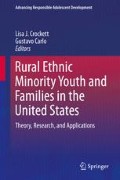Abstract
The United States is fast becoming a nation in which individuals from racial and ethnic minority groups outnumber non-Hispanic Whites. This demographic shift is also occurring in rural communities where a growing number of children are minority group members. To date, relatively little attention has focused on rural minority youth. This chapter provides a demographic overview of these young people, highlighting their diverse racial and ethnic origins as well as differences among rural communities. We provide definitions of rural, race, and ethnicity, noting the challenges and complexities of defining each of these terms. We also consider the geographic distribution of minority groups across the United States and in rural areas. This discussion is followed by a brief review of some key challenges facing minority youth from rural communities. In the final section, we briefly describe the organization of the volume and the focus of each of the chapters.
Access this chapter
Tax calculation will be finalised at checkout
Purchases are for personal use only
References
Adler, N. E., & Rehkopf, D. H. (2008). U.S. disparities in health: Descriptions, causes, and mechanisms. Annual Review of Public Health, 29(1), 235–252.
Bailey, J. M., & Preston, K. (2011). Census brief 1: Population changes on the Great Plains. Center for Rural Affairs. Retrieved from http://files.cfra.org/pdf/census-brief1-population.pdf
Burton, L. M., Lichter, D. T., Baker, R. S., & Eason, J. M. (2013). Inequality, family processes, and health in the “new” rural America. American Behavioral Scientist, 57, 1128–1151. doi:10.1177/0002764213487348.
Carlo, G., Carranza, M. A., & Zamboanga, B. (2002). Culture, ecology and Latinos on the Great Plains: An introduction. Great Plains Research, 12, 3–12.
Carlo, G., Crockett, L. J., & Carranza, M. (Eds.). (2011). Health disparities in families and youth: Theory and research applications (Nebraska symposium on motivation, Vol. 53). New York: Springer.
Centers for Disease Control and Prevention (CDC). (2014). Definitions: Racial and ethnic minority populations. Retrieved January 19, 2015, from http://www.cdc.gov/minorityhealth/populations/REMP/definitions.html
Conger, K. J., Reeb, B. T., & Chan, S. Y. S. (2015). Racial ethnic minority youth in rural America: Theoretical perspectives, conceptual challenges and future directions. In L. J. Crockett & G. Carlo (Eds.), Rural ethnic minority youth and families in the United States. New York: Springer.
Crockett, L. J., Shanahan, M. J., & Jackson-Newsom, J. (2000). Rural youth: Ecological and life course perspectives. In R. Montemayor, G. R. Adams, & T. P. Gullotta (Eds.), Adolescent diversity in ethnic, economic, and cultural contexts (pp. 43–74). Thousand Oaks, CA: Sage.
Entwisle, D. R., & Astone, N. M. (1994). Some practical guidelines for measuring youth’s race/ethnicity and socioeconomic status. Child Development, 65, 1521–1540. doi:10.1111/j.1467-8624.1994.tb00833.x.
Garcia Coll, C. G., Crnic, K., Lamberty, G., Wasik, B. H., Jenkins, R., Garcia, H. V., et al. (1996). An integrative model for the study of developmental competencies in minority children. Child Development, 67, 1891–1914.
Hart, L. G., Larson, E. H., & Lishner, D. M. (2005). Rural definitions for health policy and research. American Journal of Public Health, 95, 1149–1155.
Humes, K. R., Jones, N. A., & Ramirez, R. R. (2011, March). Overview of race and Hispanic origin: 2010. 2010 Census Briefs (C2010BR-02). Retrieved January 19, 2015, from http://www.census.gov/prod/cen2010/briefs/c2010br-02.pdf
Johnson, K. M. (2012). Rural demographic change in the new century: Slower growth, increased diversity (Issue Brief No. 44). Durham, NH: The Carsey Institute, University of New Hampshire. Retrieved January 19, 2015, from https://carsey.unh.edu/publications
Johnson, K. M., Schaefer, A., Lichter, D. T., & Rogers, L. T. (2014). The increasing diversity of America’s youth: Children lead the way to a new era (National Issue Brief No. 71). Durham, NH: The Carsey Institute, University of New Hampshire.
Lichter, D. T. (2012). Immigration and the new racial diversity in rural America. Rural Sociology, 77(1), 3–35. doi:10.1111/j.1549-0831.2012.00070.x.
Lichter, D. T., & Johnson, K. M. (2007). The changing spatial concentration of America’s rural poor population. Rural Sociology, 72(3), 331–358.
Mattingly, M. J., Johnson, K. M., & Schaefer, A. (2011). More poor kids in more poor places: Children increasingly live where poverty persists (Issue Brief No. 38). Durham, NH: The Carsey Institute, University of New Hampshire. Retrieved from The Carsey Institute at the Scholars’ Repository, http://scholars.unh.edu/carsey/150
Office of Minority Health and Health Equality. (2014). Definitions: Racial and ethnic minority populations. Retrieved January 17, 2015, from http://www.cdc.gov/minorityhealth/populations/REMP/definitions.html
Pew Hispanic Center. (2013). Statistical portrait of Hispanics in the United States, 2011. Washington, DC: Pew Hispanic Center.
Quintana, S. M., Chao, R. K., Cross, W. E., Jr., Hughes, D., Gall, S. N.-L., Aboud, F. E., et al. (2006). Race, ethnicity, and culture in child development: Contemporary research and future directions. Child Development, 77(5), 1129–1141.
U.S. Department of Health and Human Services, Health Resources and Services Administration. (n.d.). Defining the rural population. Retrieved January 18, 2015, from http://www.hrsa.gov/ruralhealth/policy/definition_of_rural.html
Vernon-Feagans, L., Cox, M., Blair, C., Burchinal, M., Burton, L., Crnic, K., & Willoughby, M. (2013). The family life project: An epidemiological and developmental study of young children living in poor rural communities. Monographs of the Society for Research in Child Development 78(Serial No. 310).
Author information
Authors and Affiliations
Corresponding author
Editor information
Editors and Affiliations
Rights and permissions
Copyright information
© 2016 Springer International Publishing Switzerland
About this chapter
Cite this chapter
Crockett, L.J., Carlo, G., Temmen, C. (2016). Ethnic and Racial Minority Youth in the Rural United States: An Overview. In: Crockett, L., Carlo, G. (eds) Rural Ethnic Minority Youth and Families in the United States. Advancing Responsible Adolescent Development. Springer, Cham. https://doi.org/10.1007/978-3-319-20976-0_1
Download citation
DOI: https://doi.org/10.1007/978-3-319-20976-0_1
Publisher Name: Springer, Cham
Print ISBN: 978-3-319-20975-3
Online ISBN: 978-3-319-20976-0
eBook Packages: Behavioral Science and PsychologyBehavioral Science and Psychology (R0)

